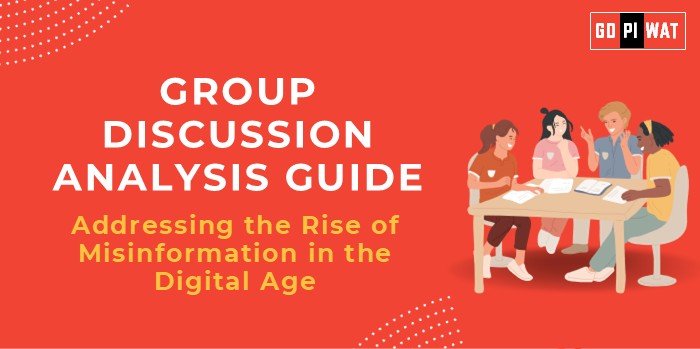📋 Group Discussion (GD) Analysis Guide
🌐 Topic: Addressing the Rise of Misinformation in the Digital Age
🌟 Introduction
- Opening Context:
“In today’s interconnected world, the rapid spread of misinformation poses significant risks, threatening societal stability, democratic processes, and economic growth globally.” - Topic Background:
Misinformation has surged with the widespread adoption of digital platforms. Governments worldwide face the challenge of addressing this while safeguarding freedom of speech and promoting digital literacy.
📊 Quick Facts & Key Statistics
- 💡 Fake News Prevalence: 62% of global respondents acknowledged the significant presence of fake news online (Global Study, 2019).
- 📉 Economic Impact: The World Economic Forum (2024) identified misinformation as a critical short-term risk to societal and economic stability.
- 🌍 Social Media Penetration: As of October 2024, 5.04 billion users, or 62.6% of the global population, are active on social media, facilitating rapid information dissemination.
- 🔍 Fact-Checking Growth: Fact-checking organizations rose from 44 in 2014 to 341 in 2022, illustrating enhanced efforts against misinformation.
🧑🤝🧑 Stakeholders and Their Roles
- 🏛️ Government: Enacts regulatory measures and promotes media literacy.
- 💻 Tech Companies: Develops algorithms for content moderation and enhances platform transparency.
- 🌟 Citizens: Plays a role in reporting misinformation and practicing critical consumption of digital content.
- 📋 NGOs and Fact-Checking Groups: Actively debunk fake news and raise awareness.
🏆 Achievements and Challenges
🎉 Achievements:
- 🌍 Rise in global fact-checking organizations, fostering greater accountability.
- 📜 Policy measures like the European Union’s Digital Services Act to combat misinformation.
- 📢 Increased public awareness campaigns by governments and NGOs.
⚠️ Challenges:
- ⚖️ Ensuring regulation doesn’t encroach on free speech rights.
- 🕵️♂️ Tackling sophisticated disinformation tactics, such as deepfakes.
- 📖 Bridging the digital literacy gap across regions and demographics.
🌍 Global Comparisons:
- 🇪🇪 Success: Estonia’s robust e-governance and misinformation safeguards.
- 🇺🇸 Struggles: The USA faces challenges in curbing misinformation during electoral processes.
- 🇮🇳 Case Study: India’s Election Commission successfully used AI tools to counter misinformation during its 2019 elections.
🗣️ Effective Discussion Approaches
📌 Opening Approaches:
- 📊 Present recent statistics on misinformation prevalence and its societal impacts.
- 📅 Cite significant events, such as misinformation during elections or the COVID-19 pandemic.
🎭 Counter-Argument Handling:
- “While over-regulation risks censorship, fostering public-private partnerships and leveraging AI-driven fact-checking can balance oversight and freedom.”
🔍 Strategic Analysis of Strengths & Weaknesses
📊 SWOT Analysis:
- ✅ Strengths: Global awareness and increased fact-checking efforts.
- ❌ Weaknesses: Inconsistent international regulations and enforcement.
- 📈 Opportunities: Expanding AI tools for detecting misinformation.
- ⚠️ Threats: Rapid evolution of misinformation tactics, including AI-generated deepfakes.
📖 Structured Arguments for Discussion
- ✅ Supporting Stance: “Governments must regulate social media platforms to curb misinformation effectively.”
- ❌ Opposing Stance: “Excessive regulation could suppress freedom of speech and innovation.”
- ⚖️ Balanced Perspective: “A balanced approach involving regulation, education, and technological tools is essential to address misinformation.”
🎓 Connecting with B-School Applications
- 📘 Real-World Applications:
- Analyze misinformation’s impact on corporate reputation and crisis management.
- 📋 Sample Questions:
- “How can AI tools be leveraged to combat misinformation?”
- “What role do public-private partnerships play in tackling digital challenges?”
- 💡 Insights for Students:
- Digital literacy, governance, and ethical decision-making are key focus areas for future leaders.


